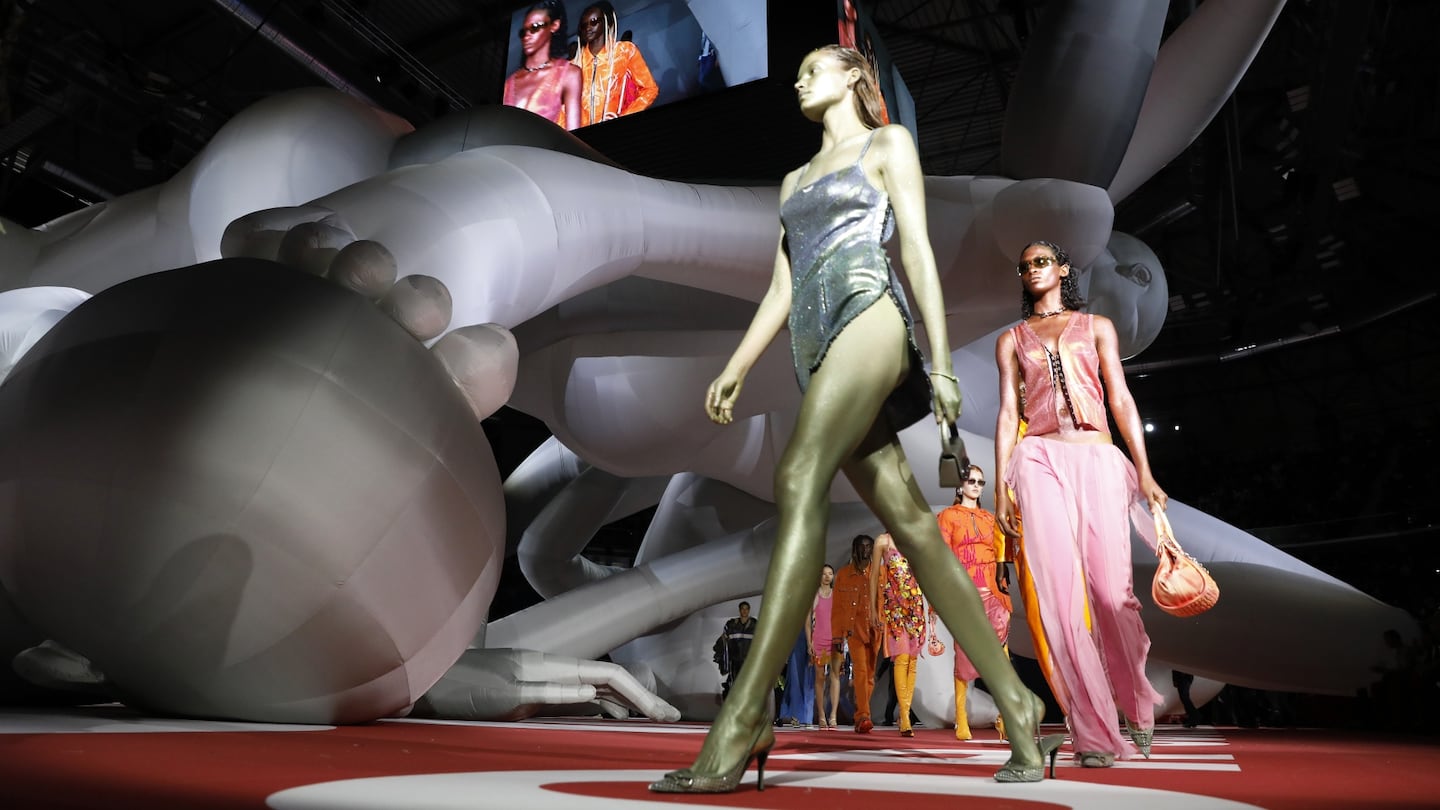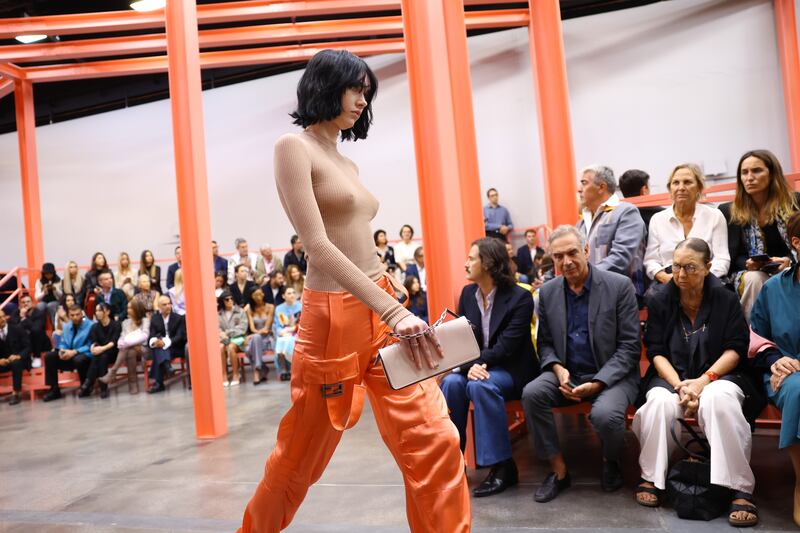
The Business of Fashion
Agenda-setting intelligence, analysis and advice for the global fashion community.

Agenda-setting intelligence, analysis and advice for the global fashion community.

MILAN — It’s human nature to try and extract themes from something as multiversal as fashion. After all, the species generally favours order over chaos.
So, after a day of wild variety on the catwalks of Milan, I’m throwing my hat in the ring for democracy as Wednesday’s subtext. It was at least a topic of conversation while, in the wider world, Joe Biden made a stand for democracy at the United Nations in the face of Vladimir Putin’s nuclear nihilism, and New York Attorney General Letitia James announced a civil lawsuit against the Trump family, who are accused of defrauding the state of at least $250 million. That surely is the will of the people at work.
Meanwhile, in Milan, Glenn Martens staged his latest show for Diesel in front of 5000 people tiered all the way to the ceiling of the huge Allianz Cloud arena.
“Everyone can be part of Diesel,” he declared, in a democratic riposte to the notion that fashion is where elitism comes home to roost. It helps, of course, that Martens’ medium at Diesel is denim, the people’s fabric. But what he does with it — and to it — is anything but basic.
ADVERTISEMENT
Denim was woven onto a transparent base to create a devoré effect for the corset attached to low-slung jeans. It was “part-solarised” (translation: sun-bleached) to create an ombré effect on a floor-sweeping coat. And the distressed effect that was probably Renzo Rosso’s unique selling proposition when he launched Diesel four decades ago was carried to a logical extreme in looks held together by their lining. Denim was plasticised, corroded and shredded into pink feathery tufts, generally abused every which way in the name of an incredible degree of almost couture-level artisanship, though Martens was quick to emphasise that the effects were achieved industrially.
0 of 71
Filling the centre of the arena was a huge inflatable sculpture of four figures entwined, recognised by Guinness as the biggest such thing in the world. It was a bit Rorschachian in that everyone seemed to see something different. My neighbour thought it was a woman giving birth, I saw a ménage à trois (well, the invitation did come with a glass butt plug — and please tell me that wasn’t just my active imagination). In actuality, it was four figures arranged in a physically impossible combination.
But when the models moved through the sculpture, each of them the size of one figure’s ear, it took on a fairy tale element. And there is something of a fairy tale in Martens’ take on Diesel. He described his post-apocalyptic tribe of sand-blasted kids — some of them green or purple-skinned — as “ready to nail life, ready to fuck you over and have fun.” Lost boys and girls raving to the end of the world, with a newly-blonded Martens as their feral shaman.
Rave was always its own kind of subversive democracy, which means the last place you’d expect to find it would be in the ateliers of Fendi. Unless you were bearing in mind that there has always been an imp of the perverse hiding inside Silvia Venturini Fendi. As she herself says, Fendi’s double F is logo-fied duality, and under Karl Lagerfeld, the brand seesawed quite happily between past and future, Classical Rome, fin-de-siecle MittelEuropa and outer space.
His successor Kim Jones is developing a much less schizy signature. True, the draped, elongated lines occasionally have the implacability of classical statuary, which also loans itself to a sci-fi elegance, but Jones’s frame of reference is a lot more immediate. Namely, the Fendi women and how they dress, especially how Delfina resuscitates clothes from her mother Silvia’s closet. There is past and future, but it’s the progression between generations rather than centuries.
0 of 66
Jones insisted that the silhouettes in his latest collection were purest Delfina: the long dresses, the baggy trousers, the skirts worn over trousers. There was utility in the straps that harnessed those trousers (now that might be a theme for Spring), there was a sportiness in the racer-backed dresses. The trompe l’oeil of a twinset with sleeve thrown over one shoulder mirrored the casual way Delfina wore her sweaters. There were quotes from Karl, because Jones is a past master at cleaving close to the ethos of whichever brand he’s designing for, in the same way that his celebration of the Baguette in New York two weeks ago was very specifically about the maximalism of Fendi circa 1997, the year the bag was released. Here, the rose print that sparked sheer tank dresses in technical organza came from a 1996 collection. Their athletic underpinnings had sports logos from 2000.
“We always bring a bit of history into it,” said Jones, but his work often gets really interesting when it’s his own history he’s bringing into play.
The collection borrowed an earthy palette from the last couture show, but it was interrupted by pink, blue and a vividly synthetic green which arrived on the catwalk as a pair of rubber platform boots, shortly followed by a green jean jacket in what looked like terrycloth (actually, shearling made to look so by the master craftspeople in the Fendi atelier) and some green thick-soled sneakers. Jones namechecked Daniel Poole, the original streetwear brand whose DP logo was all over raves in the early 90s. On the soundtrack, Gat Décor’s classic club track “Passion” underscored the reference. Jones himself enthusiastically lived this moment in British club culture, and bolting it on to Fendi’s satiny luxe felt like his own quirky addition to the lexicon of oddities that Lagerfeld compiled for the brand.
ADVERTISEMENT

Schizy? Jones scoffed at the notion. “It’s just simple answers,” he said. It was left to Silvia to remind us of the dual essence of the double FF. “Simplicity and complexity,” she added.
The democracy that was on Fausto Puglisi’s mind after his show for Roberto Cavalli was much less abstract. Italy’s general election on Sunday threatens to install Giorgia Meloni as prime minister, who would be Italy’s first far-right leader since Mussolini. Puglisi sees Meloni’s vehemently stated positions – anti-EU, anti-immigration, anti-LGBTQ rights – as a threat to Italian democracy. Those concerns, however, had no influence on the collection he showed (I concede that, at this stage in the story, my theme is a trifle stretched) unless his celebration of Hollywood at its most decorative could be construed as an escape from harsh political realities.
0 of 52
Backstage, Puglisi rhapsodised about the costume designs of Adrian, the jewellery of Tony Duquette, and the films of Hitchcock, especially “Marnie.” He opened the show with a white silk faille dress which Tippi Hedren would have done full justice to. “I wanted that naïve freshness,” said Puglisi (though I remember Marnie as being a rather dark, troubled character).
He claimed he wanted “to go classic, my way.” What that meant was an exuberant, campy collection that had glimmers of vintage Cavalli in the use of leopard and python prints — in the same outfit, even — but mostly expressed Puglisi’s own winning enthusiasms. The leitmotif was a pineapple straight out of the Duquette playbook (he was apparently Fausto’s first obsession). It was delivered as a sweet retro print on a 50s circle skirt, or a glittery cocktail carapace. Puglisi has mastered the flou of classic Cavalli — those long, sinuous gowns — but he emphasised his own precision with pleated tops and skirts that struck a Capucci chord.
“An Italian way to relate to the United States,” he explained. More knowingly Hollywood was the long pleated skirt over matching shorts with a bandeau top. Poolside, Beverly Hills, Slim Aarons ready.
From where aspirational customers are spending to Kering’s challenges and Richemont’s fashion revival, BoF’s editor-in-chief shares key takeaways from conversations with industry insiders in London, Milan and Paris.
BoF editor-at-large Tim Blanks and Imran Amed, BoF founder and editor-in-chief, look back at the key moments of fashion month, from Seán McGirr’s debut at Alexander McQueen to Chemena Kamali’s first collection for Chloé.
Anthony Vaccarello staged a surprise show to launch a collection of gorgeously languid men’s tailoring, writes Tim Blanks.
BoF’s editors pick the best shows of the Autumn/Winter 2024 season.